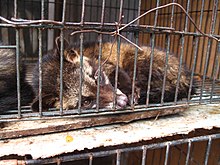
Back کشتورزی حیات وحش Persian वन्यजीव कृषि Hindi Peternakan satwa liar ID காட்டுவிலங்குப் பண்ணைத் தொழில் Tamil Yaban hayatı çiftçiliği Turkish Nuôi động vật hoang dã Vietnamese

Wildlife farming refers to the raising of traditionally undomesticated animals in an agricultural setting to produce: living animals for canned hunting and to be kept as pets; commodities such as food and traditional medicine; and materials like leather, fur and fiber.[1][2][3]
- ^ Damania, Richard; Bulte, Erwin H. (2007). "The economics of wildlife farming and endangered species conservation". Ecological Economics. 62 (3–4): 461–472. Bibcode:2007EcoEc..62..461D. doi:10.1016/j.ecolecon.2006.07.007.
- ^ P, Chardonnet; B, des Clers; J, Fischer; R, Gerhold; F, Jori; F, Lamarque (Apr 2002). "The Value of Wildlife". Revue Scientifique et Technique (International Office of Epizootics). 21 (1): 15–51. PMID 11974626. Retrieved 2020-06-04.
- ^ Tensen, Laura (2016-04-01). "Under what circumstances can wildlife farming benefit species conservation?" (PDF). Global Ecology and Conservation. 6: 286–298. Bibcode:2016GEcoC...6..286T. doi:10.1016/j.gecco.2016.03.007. ISSN 2351-9894.